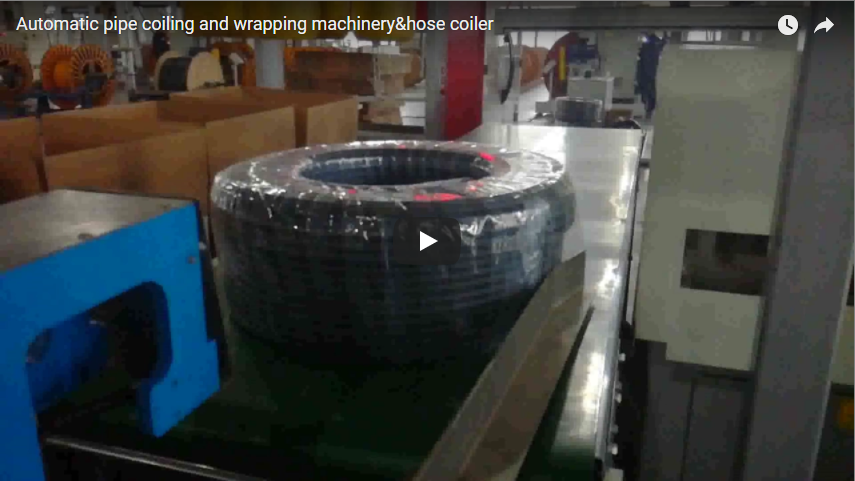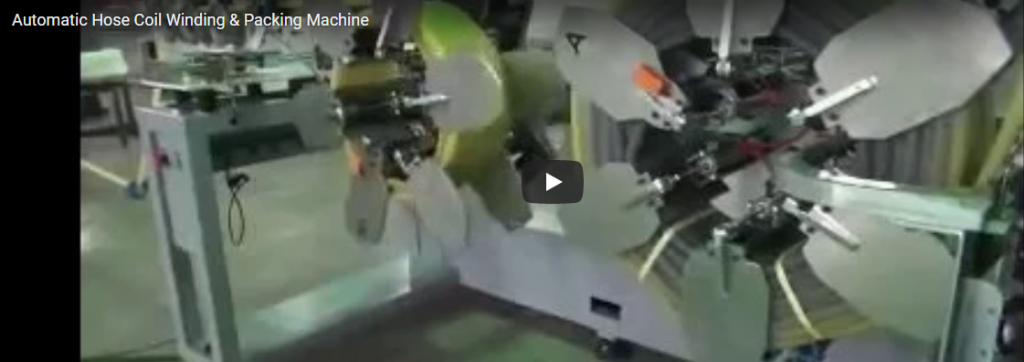Understanding the Automatic Hose Coil Making Machine: Technology, Specifications, and Applications
1. Introduction: Addressing Modern Hose Production Needs
In industries ranging from gardening supply to automotive manufacturing and construction, the efficient production of hoses and flexible tubing is critical. An Automatic Hose Coil Making Machine addresses this need by automating the process of forming hoses to specific dimensions and neatly winding them into uniform coils. This automation moves beyond simple winding; it integrates precise measurement, clean cutting, and consistent coiling, significantly boosting production throughput, ensuring product uniformity crucial for packaging and end-use, and reducing manual labor and associated risks. These machines are engineered systems typically incorporating feeding mechanisms, guiding units, coiling heads, cutters, and control systems, all synchronized for seamless operation.
2. Operational Workflow: How It Works
While specific configurations vary, the typical operational sequence of an automatic hose coiling machine involves several key stages:
- Hose Infeed: The hose or tube, often coming directly from an extrusion line and cooling trough, is fed into the machine. Guide rollers ensure proper alignment and prevent twisting.
- Measuring: A precision measuring device (often an encoder wheel or laser sensor) tracks the length of the hose passing through. This is critical for achieving accurate coil lengths according to preset parameters.
- Coiling: The measured hose is carefully guided onto a coiling head or mandrel. The machine controls the winding pattern and tension to create neat, stable coils of the desired inner and outer diameter. Traverse CUIDEs ensure the hose layers correctly.
- Cutting: Once the preset length is reached, a cutting mechanism (e.g., blade, shear) swiftly and cleanly cuts the hose. Accuracy here prevents material waste and ensures consistent product length.
- Coil Ejection/Handling: The finished coil is automatically ejected from the coiling head. Depending on the level of automation, this may involve dropping the coil onto a conveyor, transferring it to a strapping/wrapping station, or facilitating manual removal.
- Control System: A PLC (Programmable Logic Controller) synchronizes all these actions, managing speeds, lengths, counts, and timings. An HMI (Human-Machine Interface), often a touchscreen, allows operators to set parameters, monitor production, and troubleshoot issues.
3. Key Technical Specifications and Considerations
Understanding the specifications is crucial for matching a machine to production requirements.
Note: Specifications can vary significantly based on the specific model, configuration, and intended application. The parameters listed below represent typical ranges and features found in modern automatic hose coiling machines. For precise details related to the equipment shown or specific requirements, direct consultation is recommended.
- Machine Type: Automatic Hose Coiling Machine
- Typical Model Reference: HCMM Series (e.g., HCMM-2023 indicative of design generation)
- Hose Material Compatibility: Commonly handles materials like PVC, Rubber, Polyurethane (PU), PE, EVA, and composite hoses. Material stiffness and flexibility influence machine design (e.g., tension control, coiling head design).
- Hose Diameter Range: Typically accommodates diameters from a few millimeters (e.g., 10mm / 3/8") up to larger industrial sizes (e.g., 100mm / 4"). The range impacts the size and power of drive systems and guides.
- Coil Dimensions:
- Maximum Coil Outer Diameter (OD): Governs the size of the largest coil possible (e.g., up to 800mm or more).
- Coil Inner Diameter (ID): Determined by the coiling mandrel size, often adjustable or interchangeable.
- Coil Width/Height: Dictated by the traverse CUIDE range.
- Production Speed: Can range significantly, often up to 60-100 meters per minute, depending on hose diameter, material, coil size, and machine capabilities. This directly impacts throughput.
- Cutting System: Type (e.g., rotary blade, guillotine shear), precision (e.g., ±1mm to ±5mm depending on hose type and speed), and suitability for the material.
- Control System: PLC essential for automation, with HMI for operator interaction. Look for features like recipe storage, diagnostic tools, and connectivity options (e.g., Ethernet/IP for integration).
- Drive System: Motors (servo or variable frequency drive) for coiling head rotation, traverse movement, and feeder assistance. Servo drives offer higher precision for tension and positioning control.
- Power Requirements: Varies by machine size and power; typically 220V/380V/480V, 3-phase, 50/60Hz.
- Machine Footprint: Dimensions (Length x Width x Height) and Weight are crucial for layout planning. (e.g., L: 4000mm; W: 1500mm; H: 1200mm; Weight: ~750kg - example only).
- Safety Features: Essential components include emergency stops, interlocked guarding, light curtains, and adherence to safety standards (e.g., CE, ISO 13849).
- Automation Level: Ranges from basic coiling and cutting to fully integrated systems with automatic coil strapping, wrapping, and palletizing. Manual override capabilities are standard.
4. Core Applications: Where Coiling Automation Excels
4.1. Garden and Consumer Hose Production
- Challenge: High volume demand, need for consistent coil appearance for retail packaging, cost sensitivity.
- Solution: The machine delivers high-speed production (e.g., up to 100 m/min) crucial for meeting seasonal demands. Automated coiling ensures uniformity in size and shape, facilitating easy packaging (boxing, shrink-wrapping). Precise cutting minimizes waste. Reliability is key to managing large production runs efficiently.
4.2. Industrial and Construction Tubing
- Challenge: Handling larger diameters, potentially heavier or stiffer materials (e.g., reinforced rubber, thick-walled PU), requirement for robust coils that withstand handling on site.
- Solution: Machines designed for industrial use feature stronger drive systems, more robust coiling heads, and potentially assisted payoff systems. Material versatility allows processing of durable compounds like rubber and polyurethane. Precise length control ensures accurate cuts for specific installation needs, while automated coiling prepares manageable units for transport and deployment on construction sites or in factories.
4.3. Automotive and Specialized Hose Manufacturing
- Challenge: Strict dimensional tolerances, specific material requirements (fuel lines, coolant hoses, hydraulic lines), need for traceability and quality control, often dealing with pre-assembled fittings or reinforced hoses.
- Solution: Precision is paramount. The PLC control system ensures adherence to tight length and diameter specifications required by automotive standards. Advanced tension control systems prevent deformation of critical hoses. Integration capabilities allow linking with upstream processes (extrusion, BraidING) and downstream quality checks or assembly stations. Machines may need customization to handle specific hose constructions or fittings.
5. Operational Insights and Best Practices
Successfully operating an automatic hose coiling machine involves more than just pushing 'start'. Operators and technicians benefit from understanding:
- Setup and Calibration: Properly calibrating the measuring wheel/sensor is vital for accurate lengths. Setting the correct traverse pitch and coiling tension based on the hose material and diameter prevents coil collapse or hose deformation. Recipe management systems simplify changeovers between different products.
- Material Handling: The stiffness, tackiness, and weight of the hose material significantly affect performance. Ensure guides are appropriate, tension control is responsive, and static electricity is managed (especially with PVC). Consistent input from the extruder is crucial for stable coiling.
- Tension Control: Perhaps the most critical parameter. Too little tension leads to loose, unstable coils. Too much tension can stretch or flatten the hose, altering its dimensions and properties. Advanced machines use dancer arms or load cells for active tension feedback and control.
- Maintenance: Regular inspection and maintenance of cutting blades (sharpness, alignment), drive belts/chains, bearings, and sensors are essential for consistent performance and longevity. Keep pneumatic and electrical systems in good order.
- Safety Protocols: Always operate the machine with guards in place. Understand emergency stop procedures. Ensure proper training for operators regardingmaterial handling and machine operation hazards.
6. Conclusion: Enhancing Efficiency and Quality in Hose Production
Automatic hose coil making machines represent a significant technological advancement in hose and tube manufacturing. By automating the coiling, measuring, and cutting processes, they offer substantial benefits in terms of production speed, consistency, reduced labor costs, improved safety, and minimized material waste. Whether producing high volumes of garden hoses or precision automotive tubing, understanding the capabilities, specifications, and operational nuances of these machines is key to leveraging their full potential for efficient and high-quality output. Integrating such automation is often a critical step for manufacturers looking to remain competitive in demanding global markets.
Related Resources
For more information on related equipment, see:
Horizontal Coiling Machine






